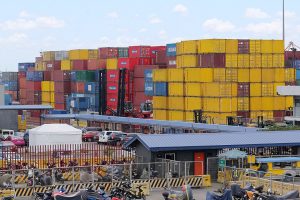
Export growth of 40% needed to meet targets set in PEDP
By Justine Irish D. Tabile, Reporter
EXPORTS will need to grow 40% this year to be able to hit the $143.4-billion target set for 2024 in the Philippine Export Development Plan (PEDP) 2023-2028, according to the Department of Trade and Industry (DTI).
“For us to be able to catch up with our PEDP targets, we need to grow by about 40% this year … because we did not meet the target for 2023,” according to Bianca Pearl R. Sykimte, director of the DTI-Export Marketing Bureau.
Ms. Sykimte said that the DTI is only projecting at least 10% export growth this year.
“Based on market projections … We expect about 10% growth (in 2024). So definitely, we will try to achieve more than 10% for export growth but to be able to catch up with the PEDP target of around $140 billion, we need to grow by 40%,” she added.
“It might be hard, but we really need to attract investment to build our domestic capacity. Again, 60% of our exports are electronics, and if you look at that sector it really is investment-driven,” she added.
Merchandise and services exports in 2023 under the PEDP were set a target of $126.8 billion. The Development Budget Coordination Committee (DBCC) projected goods exports to decline 4% in 2023.
For 2024, the DBCC projected goods exports to grow 5%, and then by 6% annually between 2025 and 2028.
Preliminary estimates by the Philippine Statistics Authority indicate that merchandise exports in the first 11 months of 2023 amounted to $67.03 billion, down 8.4% from a year earlier.
Preliminary estimates from the Bangko Sentral ng Pilipinas indicate that service exports grew 20.7% to $34.73 billion in the first nine months of 2023.
“So we are looking at, based on and consistent with DBCC projections, about a 4% decline for the export of goods (for 2023); for services, we are much more optimistic,” Ms. Sykimte said.
“And when we estimate the last three months or the last quarter of the year, we are still looking at 5% growth for total exports — both goods and services,” she added.
However, she said the 5% “is still higher in terms of growth rate in the previous PEDP wherein the average growth rate for exports was about 4%.”
The DTI’s strategy to catch up with the PEDP target is to address concerns about the ease of doing business (EoDB) and make it easier for manufacturers to export, Ms. Sykimte said.
“The priority is to address concerns of EoDB, which include the regulatory issues that make it more expensive for manufacturers to export,” she added.
She said Trade Secretary Alfredo E. Pascual has asked regulatory agencies to take a more developmental approach in their oversight of exporters.
“I would like to add that part of our strategy of increasing exports is really to bring in export-oriented foreign manufacturers to locate in the Philippines and for them to bring along their suppliers as well,” Mr. Pascual said.
Trade Undersecretary Ceferino S. Rodolfo said the focus of the department is to attract investment in manufacturing and exports.
“Just for context, our average nickel exports are $1 billion. Indonesia went from $1 billion in exports in 2015 to $20 billion because of nickel processing, and now they are at $30 billion,” said Mr. Rodolfo.
“That is the magnitude that we are looking for in terms of the value-add and it is quite substantial. So, generating investments is really key for value-add,” he added.



